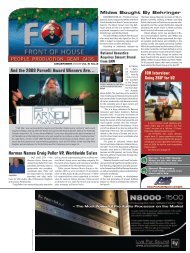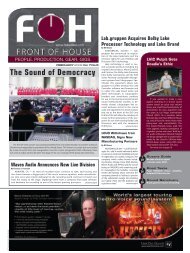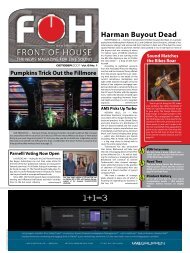May Issue - FOH Online
May Issue - FOH Online
May Issue - FOH Online
Create successful ePaper yourself
Turn your PDF publications into a flip-book with our unique Google optimized e-Paper software.
Whitehorse, Yukon, with its population<br />
of 23,000, has a cozy, small-<br />
town feel, as people have time to<br />
chat, and cars stop for people to cross the<br />
street even if the traffic light is green. This<br />
city is also one of the best places to see the<br />
mysterious phenomenon called the Northern<br />
Lights or Aurora Borealis. During a clear<br />
winter night when there is a high level of<br />
solar wind, the electrons discharge like florescent<br />
lights, and tourists come from all<br />
over the world hoping to see the sky light<br />
up in green swirls.<br />
When the 2007 Canada Winter Games<br />
were awarded to the city of Whitehorse,<br />
they said they would put on the biggest<br />
show north of the 60th parallel. What they<br />
didn’t say was that it would be the coldest<br />
Canada Winter Games ever. Daytime temperatures<br />
during the games ranged from<br />
minus 27°F (minus 33°C) to minus 40°F (minus<br />
40°C).<br />
The biggest challenges for the games<br />
were keeping costs low while maximizing<br />
their value to the community of Whitehorse.<br />
To help reduce costs, a two-and-ahalf<br />
week spring break was scheduled to<br />
coincide with the games so that students<br />
could volunteer. In the end, more than 4000<br />
volunteers were recruited. Families rented<br />
their homes not only to show their warm<br />
16<br />
Production Profile<br />
K e e p U n t i l<br />
S h o w<br />
By TonyMah<br />
MAY 2007<br />
Yukon hospitality, but also to alleviate the<br />
shortage of hotel space.<br />
The organizing committee needed to<br />
build a venue that was large enough to host<br />
the opening and closing ceremonies. Rather<br />
than build a permanent facility that would<br />
have been empty once the games were<br />
over, the committee decided to construct a<br />
44,000-square-foot heated tent. The temperature<br />
in the “heated” tent rose to only 48°F<br />
(9°C). This was warm enough to keep equipment<br />
like DSP processors, speakers and<br />
mixing consoles within safe operating conditions,<br />
but the crew were seen dressed in<br />
outdoor winter clothing, huddled near personal<br />
heaters or competing for spots near<br />
the heating tubes throughout the show.<br />
The opening and closing ceremonies<br />
were one-off shows, but because Whitehorse<br />
is so far, north it takes a week to truck<br />
the gear from Vancouver. This meant that the<br />
organizing committee had to rent the gear<br />
for a month. ProShow, one of Vancouver’s<br />
premier full service Audio/Visual providers,<br />
supplied all the audio for the ATCO Centre<br />
tent. Mark Fisher and Benoit Laurence from<br />
Proshow oversaw the project and made sure<br />
everyone stayed happy.<br />
“The gig is a typical corporate show,”<br />
says Fisher, except for the extreme cold and<br />
the extra planning to make sure nothing was<br />
Forget the Plow,<br />
Build a Speaker<br />
The Michigan Tech Audio Engineering<br />
Society recently built a nearly-<br />
20,000-watt speaker array made of<br />
snow. Yes snow, the white fluffy stuff that<br />
falls from the sky. It seems they needed<br />
mega audio power for Michigan Tech’s<br />
Winter Carnival, which has a competition<br />
for impressive snow sculptures.<br />
The university AES group used computer<br />
modeling to design the horns as<br />
well as the line-array speaker configuration,<br />
building them from formed snow<br />
and wood. The audio source came from<br />
an optical output of a student’s computer,<br />
which ran into two Behringer DCX2496<br />
speaker management systems. The speakers<br />
were powered by nine Behringer<br />
EP2500 amps and one Crown XLS602.<br />
The snow array had front and rear<br />
firing sections for covering the campus.<br />
The front pointing speakers consisted of<br />
eight Selenium 2-inch dome compression<br />
drivers with 1-inch throat horns, 16<br />
5-inch sealed back MCM cone drivers, six<br />
Selenium 15-inch drivers using a 4-foot<br />
deep snow horn with 4-foot by 8-foot<br />
mouth and 7-foot by 2-inch throat, plus<br />
six ElectroVoice 18-inch drivers using a<br />
15-foot deep snow horn with 15-foot by<br />
6-foot mouth and an 18-inch throat. The<br />
rear-pointing speakers consisted of three<br />
Eminence 2-inch dome compression drivers<br />
with 1-inch throat horns, and the lows<br />
were six Selenium/EV 15-inch drivers (not<br />
horn loaded).<br />
The amazing snow array took between<br />
six and 15 AES members about four hours<br />
per night for three weeks to complete. According<br />
to Tommy Bartlet, one of the project<br />
members, it made quite a great dance system<br />
for the carnival party, which went into<br />
the early morning hours. “We pushed the<br />
nine EP2500’s just into clipping from 7 p.m.<br />
to 4 a.m. with no problems, even in freezing<br />
conditions. There’s nothing like seeing the<br />
red clip lights blink on nine EP2500s.” Police<br />
were reported to have had complaints from<br />
three miles away due to the volume.<br />
www.fohonline.com<br />
For the 2007 Canadian Winter Games they only heated<br />
the venue enough to keep the <strong>FOH</strong> gear operational. . .<br />
missing. “That far north you can’t just call the<br />
shop and ask for something you forgot.” To<br />
keep the costs reasonable, all the gear was<br />
owned by Proshow and there were no crossrentals<br />
or outboard gear. Local volunteers<br />
helped unload, and when local providers<br />
didn’t have the appropriate gear Craig Marcuk,<br />
a local freelancer, was hired.<br />
To avoid having to fly in a big crew,<br />
Fisher, Laurence and Marcuk spent two long<br />
days setting up the sound system. While everyone<br />
had different roles, the entire crew of<br />
sound, lights, video projection and staging<br />
were willing to help each other out. Three<br />
stages ran the length of the tent. Hanging<br />
from each side of centerstage were eight<br />
Meyer M’elodie speakers and a pair of Meyer<br />
Rehearsal for the opening ceremonies<br />
700HP subs, processed by a Meyer Galileo.<br />
Extreme left and right each had a pair of<br />
EAW KF650E speakers and a single Meyer<br />
650P subwoofer. Fisher used 10 Electro-<br />
Voice Sx300s for front fill and 10 more for<br />
delays for the bleachers. Floor wedges were<br />
five mixes run through eight EAW SM200s.<br />
All the conventional boxes were powered by<br />
14 QSC PLX amps and processed with three<br />
dbx Driverack 4800s.<br />
Fisher and his crew used SMAART to set<br />
the tent’s delays and EQ the conventional<br />
boxes to match the M’elodies. With the three<br />
stages being so long, instead of delaying<br />
all the fill speakers to <strong>FOH</strong>, Fisher set up his<br />
delays by putting his measurement microphone<br />
in front of each delay speaker along<br />
The front pointing speakers under construction

















